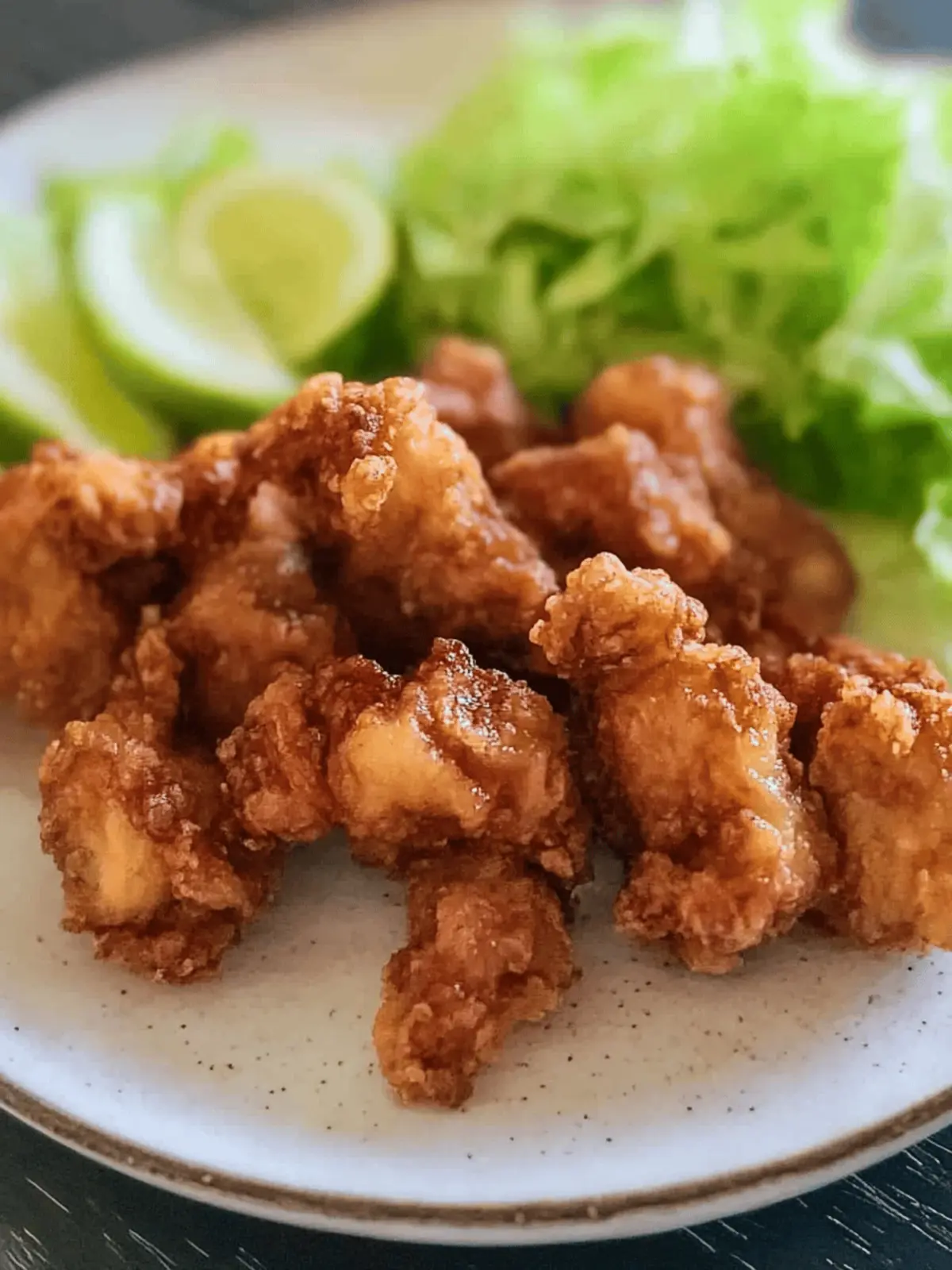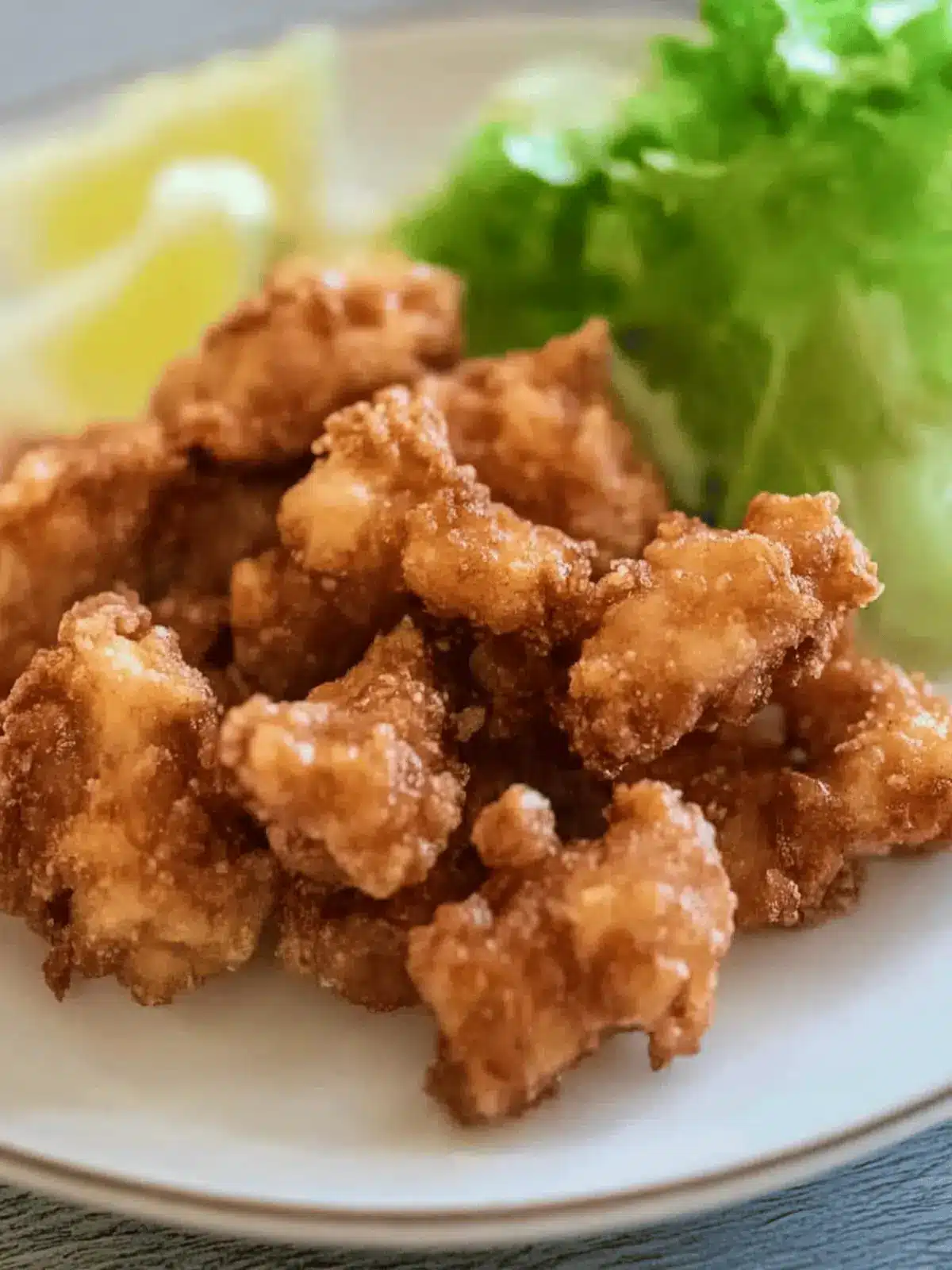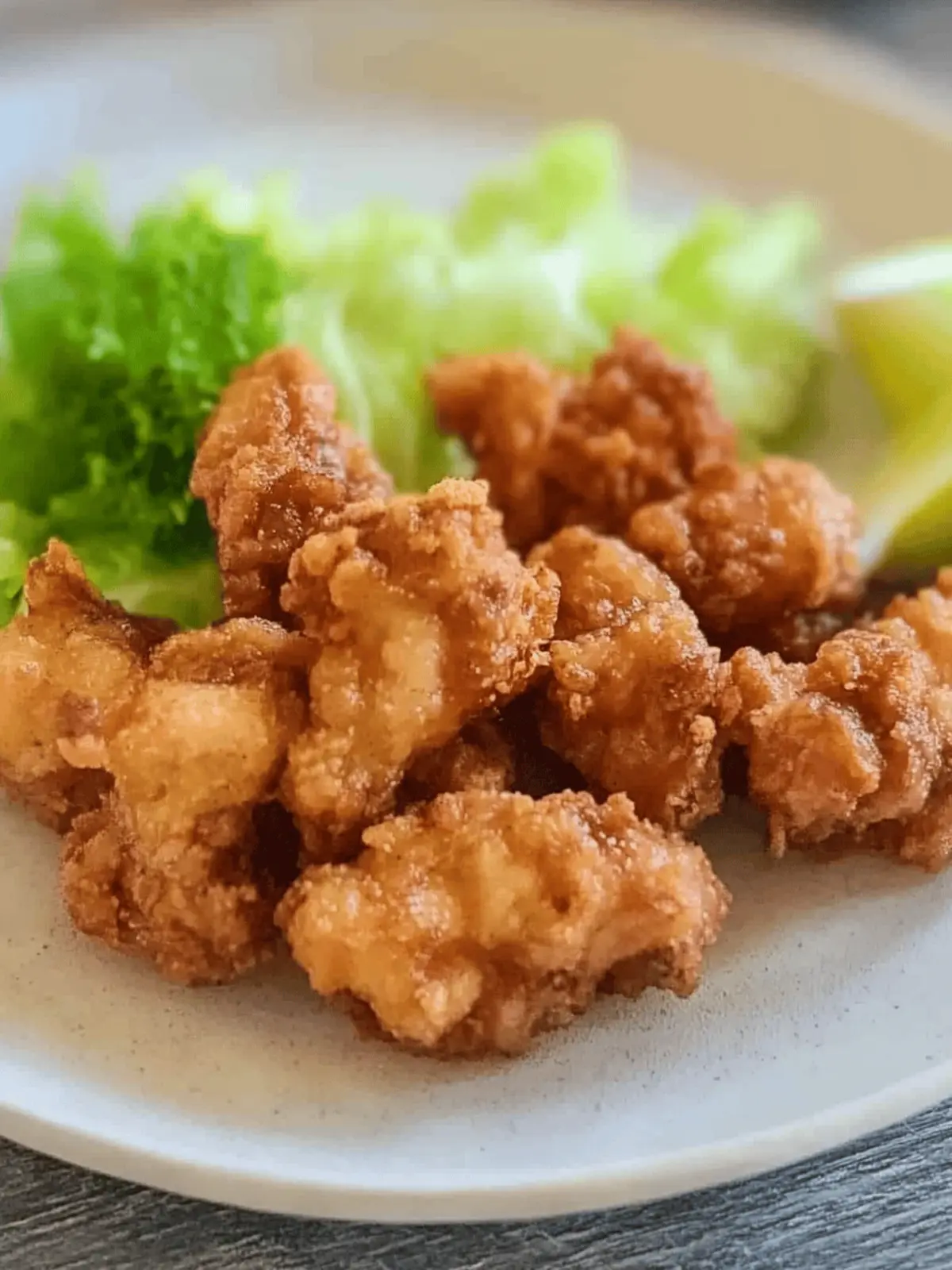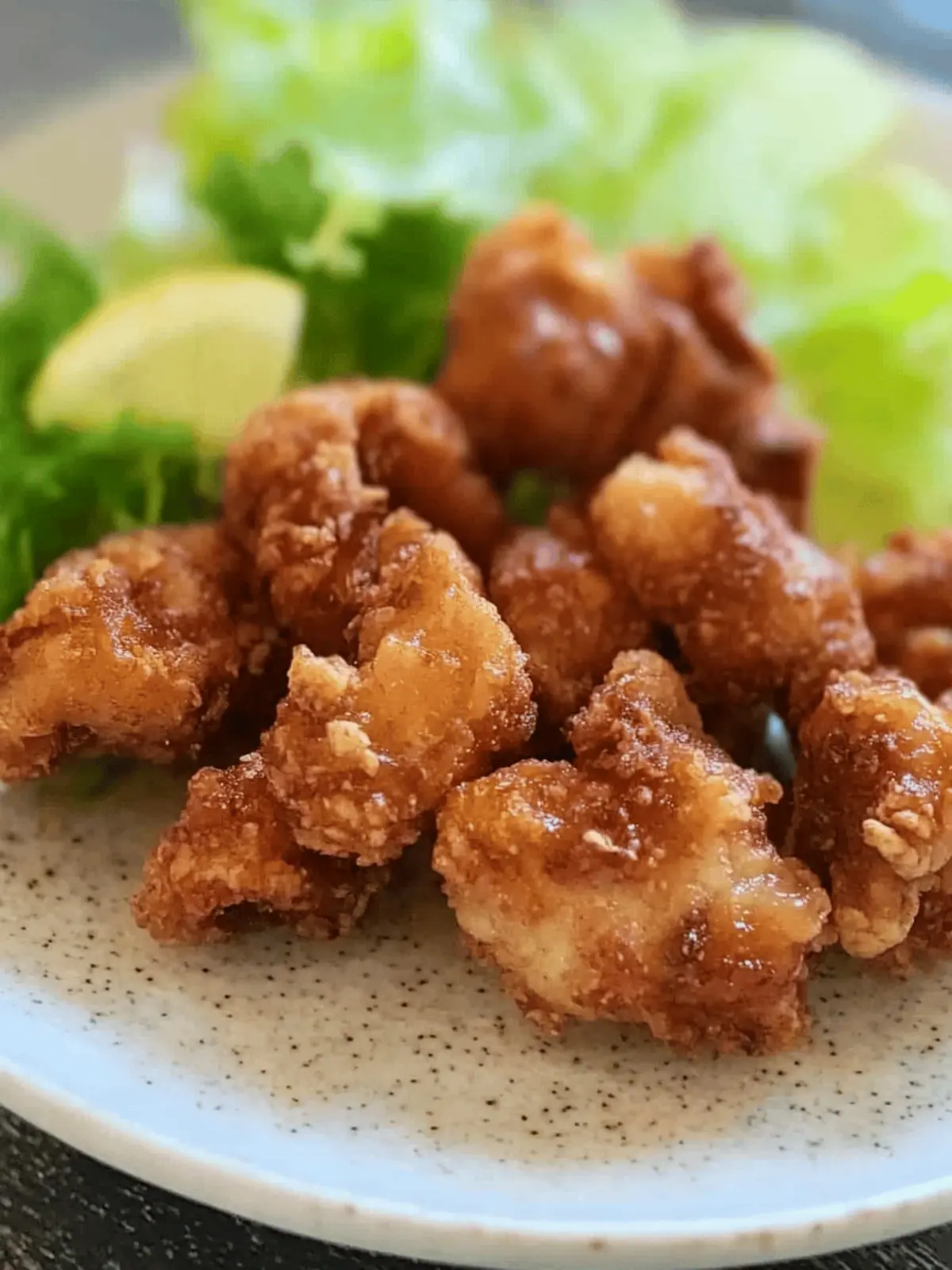There’s a particular joy that comes with discovering a dish that effortlessly marries crispy textures and rich flavors—like a warm, inviting hug for your taste buds. When I first tasted Japanese Fried Chicken, or Karaage, I was immediately captivated by its golden, crunchy exterior that gives way to tender, juicy meat encased inside. This recipe not only brings the wonderful umami notes of soy sauce, ginger, and garlic to life but also serves as a healthier alternative to the traditional fried chicken we’re all accustomed to.
As someone who often seeks inspiration in the kitchen, the beauty of Karaage lies in its versatility; whether you’re serving it as a delightful appetizer or a standout main dish, it’s guaranteed to impress. With simple ingredients and straightforward steps, you’ll find that this culinary gem is a gateway to experiencing the vibrant essence of Japanese cuisine right at home. Join me as I guide you through creating this crispy delight that’s both satisfying to make and even more delightful to eat!
Why is Japanese Fried Chicken so irresistible?
Crispy perfection: Each bite delivers a satisfying crunch that keeps you coming back for more.
Umami explosion: The rich marinade of soy sauce, ginger, and garlic creates an explosion of flavor that tantalizes your taste buds.
Versatile dishes: Enjoy it as a main course, a snack, or a party appetizer, catering to all occasions!
Healthy indulgence: With a lighter coating, this fried chicken option is a delightful alternative for health-conscious foodies.
Quick and easy: Simple prep and cooking methods mean you’ll have delicious Karaage ready in no time—perfect for busy weeknights or weekend feasts!
Japanese Fried Chicken Ingredients
For the Chicken
• Chicken thighs – Tender and juicy, they hold flavor beautifully; substitute with chicken breasts for a leaner option.
For the Marinade
• Soy sauce – Adds umami depth and saltiness to the Asian vibe; tamari works for gluten-free needs.
• Sake – Elevates the flavor profile; can be swapped with dry white wine or rice vinegar if needed.
• Grated ginger – Infuses a fresh, zesty aroma; use fresh for the best results.
• Garlic – A must for flavor; can be minced or substituted with garlic powder.
• Sesame oil – Imparts a nutty essence; vegetable oil is a suitable alternative if not available.
For the Coating
• Potato starch (or cornstarch) – Essential for achieving the crispy outer layer; ensures a light texture.
• All-purpose flour – Enhances crunchiness when paired with starch; choose gluten-free flour as a substitute if desired.
For Frying and Serving
• Vegetable oil – Necessary for frying; opt for oils with high smoke points like canola.
• Lemon wedges – Provide a zesty freshness when served; feel free to omit if not garnishing.
• Japanese mayo – Optional dipping sauce that adds creamy goodness of flavor.
This Japanese Fried Chicken can transform any meal into a delightful feast, making it a must-try recipe for home cooks!
How to Make Japanese Fried Chicken
-
Prepare marinade: In a medium bowl, whisk together soy sauce, sake, grated ginger, minced garlic, and sesame oil. This aromatic blend serves as the flavorful base for your chicken, making it irresistible.
-
Marinate chicken: Add the chicken thighs to the marinade, ensuring each piece is thoroughly coated. Cover and refrigerate for at least 30 minutes, or up to 4 hours for deeper flavor. Patience is key here!
-
Prep coating: In a separate bowl, combine potato starch and all-purpose flour. This mixture will give your chicken that signature crunch when fried.
-
Heat oil: In a deep pan or wok, heat enough vegetable oil to submerge the chicken to about 170°C (340°F). A thermometer will help ensure the perfect frying temperature for that golden crisp.
-
Coat chicken: Take marinated chicken pieces out of the fridge and lightly coat each with the starch-flour mixture, shaking off any excess. This step is crucial for a light and crispy texture.
-
Fry chicken: In batches, carefully place the chicken into the hot oil and fry for 4-5 minutes until they reach a golden brown color and crispy texture. Always fry in small batches to avoid overcrowding!
-
Drain & serve: Once fried, remove the chicken from the oil and drain on paper towels to eliminate excess grease. Serve hot with lemon wedges for freshness, or add a side of Japanese mayo for dipping if you desire some creaminess.
Optional: Serve it alongside steamed rice or in a bento box for added flair.
Exact quantities are listed in the recipe card below.
Storage Tips for Japanese Fried Chicken
- Fridge: Store leftovers in an airtight container for up to 3 days; this will help maintain flavor and ensure freshness.
- Freezer: For longer storage, freeze Japanese Fried Chicken for up to 1 month. Ensure it’s wrapped well to prevent freezer burn.
- Reheating: Reheat in an oven or air fryer at 180°C (350°F) for about 10-15 minutes; this will help regain the crispy texture you love.
- Avoid sogginess: Do not reheat in the microwave as it can make the chicken lose its delightful crunch.
Expert Tips for Japanese Fried Chicken
- Marination Matters: Ensure you marinate the chicken for at least 30 minutes; the longer it sits, the more flavorful the Japanese Fried Chicken will be.
- Light Coating: Use a light hand when coating with the potato starch and flour mixture to achieve that signature crispy texture without excess greasiness.
- Temperature Control: Keep the oil temperature steady at 170°C (340°F); fluctuations can lead to soggy or burnt chicken.
- Work in Batches: Avoid overcrowding the frying pan; this helps maintain the temperature and ensures each piece gets crispy.
- Proper Draining: Let the fried chicken drain on paper towels or a wire rack to keep it from becoming oily, preserving that delightful crunch.
Make Ahead Options
These Crispy Japanese Fried Chicken (Karaage) are perfect for meal prep, saving you time on busy weeknights! You can marinate the chicken up to 24 hours in advance, letting the flavors develop for more delicious results. Just ensure you refrigerate the marinated chicken in an airtight container. Additionally, you can prepare the coating mixture (potato starch and flour) up to 3 days ahead and store it in a zip-top bag to keep it fresh. When you’re ready to serve, simply heat the oil and coat the marinated chicken before frying for that restaurant-level crunch. Trust me, your homemade karaage will be just as delightful!
What to Serve with Japanese Fried Chicken?
Enhancing your dining experience with the perfect sides can make your meal truly memorable.
-
Steamed Rice: The natural flavors of fluffy white or jasmine rice pair wonderfully with the savory notes of karaage, absorbing the delicious juices.
-
Crispy Asian Slaw: A refreshing mix of cabbage, carrots, and sesame dressing adds a crunchy contrast that complements the tender chicken beautifully.
-
Miso Soup: The warm, umami-rich broth is an ideal light accompaniment, providing a soothing balance to the crispy delight of your fried chicken.
-
Chili Dipping Sauce: Offering a delightful kick, this tangy addition elevates each bite, making your meal more adventurous and exciting.
-
Pickled Vegetables: Quick-pickled daikon or cucumbers bring a burst of acidity that cuts through the richness of the chicken, refreshing your palate.
-
Japanese Potato Salad: Creamy yet light, this dish blends smoothly with Karaage’s crispy texture, making each bite a harmonious experience.
-
Cold Sapporo Beer: Enjoy this light lager to enhance the flavors of your meal, providing a satisfying chill alongside the warm chicken.
Pair these delightful options with your Japanese Fried Chicken and create an unforgettable feast that resonates with flavor and freshness!
Japanese Fried Chicken Variations
Customize your Karaage with these delightful twists that will make your taste buds sing with joy!
- Shio Karaage: Marinate with salt instead of soy sauce for a lighter and cleaner flavor that highlights the chicken’s natural taste.
- Zangi: Add a hint of chili and extra garlic for a spicy twist that’ll kick up the heat without overpowering the savory notes. Enjoy each bite as it dances on your palate!
- Tatsutaage: Use only potato starch in the coating for an even lighter and crunchier texture, making each piece feel airy and delightful.
- Vegan Option: Substitute chicken with firm tofu or oyster mushrooms while following the same marination and frying technique. You’ll be amazed at how beautifully these alternatives absorb the flavors!
- Herb-Infused: Add fresh herbs like cilantro or shiso to your marinade for an aromatic touch that elevates your Chicken Karaage into gourmet territory.
- Curry Flavor: Mix in some curry powder with the marinade for a unique twist that brings a vibrant and savory depth to your fried chicken.
- Honey Soy Glaze: After frying, brush your chicken pieces with a honey-soy mixture for a sweet and sticky exterior, balancing the savory with just the right amount of sweetness.
- Citrus Burst: Squeeze fresh lime or yuzu juice over the fried chicken before serving. This adds a bright zing that cuts through the richness and leaves you craving more!
Japanese Fried Chicken Recipe FAQs
What type of chicken is best for Karaage?
For the best flavor and texture, I recommend using chicken thighs, as they remain tender and juicy during frying. If you prefer a leaner option, chicken breasts can be substituted, but they may not be as moist.
How should I store leftovers of Japanese Fried Chicken?
Leftovers can be stored in an airtight container in the fridge for up to 3 days. This helps retain the flavor and freshness of the chicken. For longer storage, freeze the karaage for up to 1 month. When freezing, wrap it well to prevent freezer burn.
Can I freeze Karaage, and if so, how?
Absolutely! To freeze your Japanese Fried Chicken, first, let it cool completely once fried. Then, place the chicken in a single layer on a baking sheet and freeze until solid, about 1-2 hours. Afterward, transfer the frozen pieces to a resealable freezer bag or airtight container, ensuring to remove as much air as possible. This method prevents them from sticking together and keeps them crispy when reheating!
What if my fried chicken comes out greasy?
If your Karaage seems greasy, it might be due to a couple of factors. First, make sure you’re using a light coating of potato starch and flour; an overly thick layer can trap excess oil. Also, ensure the frying oil is hot enough (around 170°C or 340°F) before adding the chicken. Cooking in smaller batches will help maintain oil temperature, providing a nice crispy finish without greasiness.
Is Japanese Fried Chicken safe for pets?
While a small piece may not pose a serious threat, it’s best to avoid feeding pets fried foods, including Karaage. The spices and oil can upset their stomachs and may cause digestive issues. It’s always safest to stick to pet-friendly options!
Can I use gluten-free alternatives for this recipe?
Very much so! You can substitute soy sauce with tamari for a gluten-free version. Both potato starch and all-purpose flour have gluten-free alternatives; use gluten-free flour blends in place of regular flour to maintain the crispy texture without compromising on taste!

Crispy Japanese Fried Chicken: A Flavorful Homemade Delight
Ingredients
Equipment
Method
- In a medium bowl, whisk together soy sauce, sake, grated ginger, minced garlic, and sesame oil.
- Add the chicken thighs to the marinade, ensuring each piece is thoroughly coated. Cover and refrigerate for at least 30 minutes, or up to 4 hours.
- In a separate bowl, combine potato starch and all-purpose flour.
- In a deep pan or wok, heat enough vegetable oil to submerge the chicken to about 170°C (340°F).
- Take marinated chicken pieces out of the fridge and lightly coat each with the starch-flour mixture.
- In batches, carefully place the chicken into the hot oil and fry for 4-5 minutes until golden brown.
- Once fried, remove the chicken from the oil and drain on paper towels.








